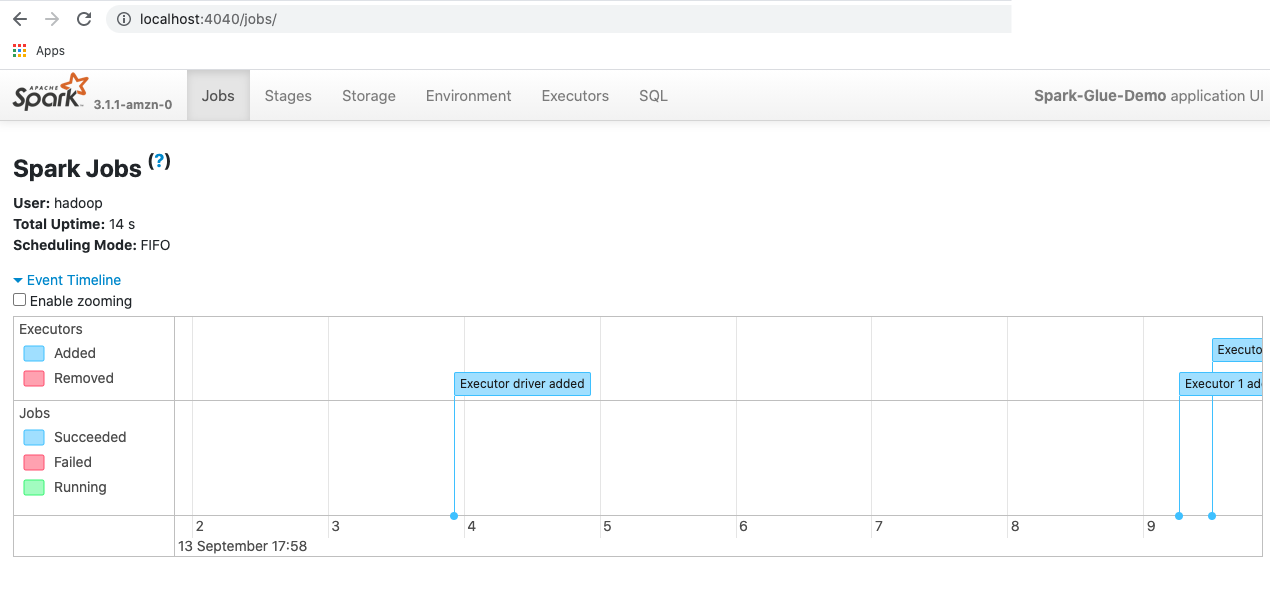Connect to Spark UI running on the Driver Pod¶
To obtain more detail about their application or monitor their job execution, Spark application developers can connect to Spark-UI running on the Driver Pod.
Spark UI (Spark history server) is packaged with EMR on EKS out of the box. Alternatively, if you want to see Spark UI immediately after the driver is spun up, you can use the instructions in this page to connect.
This page shows how to use kubectl port-forward to connect to the Job's Driver Pod running in a Kubernetes cluster. This type of connection is useful for debugging purposes.
Pre-Requisites
- AWS cli should be installed
- "kubectl" should be installed
- If this is the first time you are connecting to your EKS cluster from your machine, you should run
aws eks update-kubeconfig --name --regionto download kubeconfig file and use correct context to talk to API server.
Submitting the job to a virtual cluster¶
Request
cat >spark-python.json << EOF
{
"name": "spark-python-in-s3",
"virtualClusterId": "<virtual-cluster-id>",
"executionRoleArn": "<execution-role-arn>",
"releaseLabel": "emr-6.3.0-latest",
"jobDriver": {
"sparkSubmitJobDriver": {
"entryPoint": "s3://<s3 prefix>/trip-count.py",
"sparkSubmitParameters": "--conf spark.driver.cores=4 --conf spark.executor.memory=20G --conf spark.driver.memory=20G --conf spark.executor.cores=4"
}
},
"configurationOverrides": {
"applicationConfiguration": [
{
"classification": "spark-defaults",
"properties": {
}
}
],
"monitoringConfiguration": {
"cloudWatchMonitoringConfiguration": {
"logGroupName": "/emr-containers/jobs",
"logStreamNamePrefix": "demo"
},
"s3MonitoringConfiguration": {
"logUri": "s3://joblogs"
}
}
}
}
EOF
aws emr-containers start-job-run --cli-input-json file:///spark-python.json
Once the job is submitted successfully, run kubectl get pods -n <virtual-cluster-k8s-namespace> -w command to watch all the pods, until you observe the driver pod is in the "Running" state. The Driver pod's name usually is in spark-<job-id>-driver format.
Connecting to the Driver Pod¶
Spark Driver Pod hosts Spark-UI on port 4040. However the pod runs within the internal Kubernetes network. To get access to the internal Kubernetes resources, kubectl provides a tool ("Port Forwarding") that allows access from your localhost. To get access to the driver pod in your cluster:
1- Run kubectl port-forward <driver-pod-name> 4040:4040
The result should be the following:
Forwarding from 127.0.0.1:28015 -> 27017
Forwarding from [::1]:28015 -> 27017
2- Open a browser and type http://localhost:4040 in the Address bar.
You should be able to connect to the Spark UI:

Consideration¶
In some cases like long-running Spark jobs, such as Spark streaming or large Spark SQL queries can generate large event logs. With large events logs, it might happen quickly use up storage space on running pods and sometimes encounter to experience blank UI or even OutOfMemory errors when you load Persistent UIs. To avoid these issues, we recommend that you follow either by turn on the Spark event log rolling and compaction feature (default emr-container-event-log-dir - /var/log/spark/apps) or use S3 location to parse the log using self hosted of Spark history server.